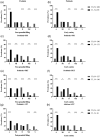Evaluation of main functional dyspepsia symptoms after probiotic administration in patients receiving conventional pharmacological therapies
- PMID: 33472489
- PMCID: PMC7829611
- DOI: 10.1177/0300060520982657
Evaluation of main functional dyspepsia symptoms after probiotic administration in patients receiving conventional pharmacological therapies
Abstract
Objective: Postprandial distress syndrome (PDS) and epigastric pain syndrome (EPS) are the two main forms of functional dyspepsia (FD). Probiotics are a promising therapy for FD, but current data remains heterogeneous. This work aims to evaluate a probiotic combination of Lacticaseibacillus rhamnosus LR04 (DSM 16605), Lactiplantibacillus pentosus LPS01 (DSM 21980), Lactiplantibacillus plantarum LP01 (LMG P-21021), and Lactobacillus delbrueckii subsp. delbruekii LDD01 (DMS 22106), alone or together with other pharmacological therapies, for clinical improvement of symptoms associated with FD.
Methods: Patients with FD were enrolled and divided into two groups: PDS and EPS. Probiotic alone or combined with prokinetics, antacids, or proton-pump-inhibitors were administered for 30 days. A progressive-score scale was used to evaluate symptoms in all patients at the beginning of the trial and at 15 days after the end of treatment.
Results: A cohort of 2676 patients were enrolled (1 357 with PDS; 1 319 with EPS). All patients showed significant improvements in dyspeptic symptoms following treatment. In patients with PDS, probiotic alone resulted in the lowest prevalence of symptoms following treatment, while patients with EPS showed no clear between-treatment differences.
Conclusions: Dyspeptic symptoms were reduced following treatment in all patients.
Keywords: Dyspepsia; Functional disorders; Probiotics.
Conflict of interest statement
Figures



Similar articles
-
The innovative potential of Lactobacillus rhamnosus LR06, Lactobacillus pentosus LPS01, Lactobacillus plantarum LP01, and Lactobacillus delbrueckii Subsp. delbrueckii LDD01 to restore the "gastric barrier effect" in patients chronically treated with PPI: a pilot study.J Clin Gastroenterol. 2012 Oct;46 Suppl:S18-26. doi: 10.1097/MCG.0b013e318267b55d. J Clin Gastroenterol. 2012. PMID: 22955351 Clinical Trial.
-
Rome III functional dyspepsia subdivision in PDS and EPS: recognizing postprandial symptoms reduces overlap.Neurogastroenterol Motil. 2015 Aug;27(8):1069-74. doi: 10.1111/nmo.12585. Neurogastroenterol Motil. 2015. PMID: 26220647
-
Discriminant value of Rome III questionnaire in dyspeptic patients.Saudi J Gastroenterol. 2011 Mar-Apr;17(2):129-33. doi: 10.4103/1319-3767.77244. Saudi J Gastroenterol. 2011. PMID: 21372351 Free PMC article. Clinical Trial.
-
Current and emerging therapeutic options for the management of functional dyspepsia.Expert Opin Pharmacother. 2020 Feb;21(3):365-376. doi: 10.1080/14656566.2019.1707805. Epub 2020 Jan 3. Expert Opin Pharmacother. 2020. PMID: 31899982 Review.
-
[Functional Dyspepsia].Korean J Gastroenterol. 2019 Feb 25;73(2):77-83. doi: 10.4166/kjg.2019.73.2.77. Korean J Gastroenterol. 2019. PMID: 30845383 Review. Korean.
Cited by
-
Relative Frequency of Gastrointestinal Functional Disorders in Patients with Inflammatory Bowel Disease Based on Rome IV: A Case-Control Study.Adv Biomed Res. 2024 Jul 29;13:43. doi: 10.4103/abr.abr_369_23. eCollection 2024. Adv Biomed Res. 2024. PMID: 39224402 Free PMC article.
-
Eosinophils, Hypoxia-Inducible Factors, and Barrier Dysfunction in Functional Dyspepsia.Front Allergy. 2022 May 31;3:851482. doi: 10.3389/falgy.2022.851482. eCollection 2022. Front Allergy. 2022. PMID: 35769556 Free PMC article. Review.
-
Functional Gastrointestinal Disorders with Psychiatric Symptoms: Involvement of the Microbiome-Gut-Brain Axis in the Pathophysiology and Case Management.Microorganisms. 2022 Nov 7;10(11):2199. doi: 10.3390/microorganisms10112199. Microorganisms. 2022. PMID: 36363791 Free PMC article. Review.
-
Lacticaseibacillus paracasei HP7 Improves Gastric Emptying by Modulating Digestive Factors in a Loperamide-Induced Functional Dyspepsia Mouse Model.J Microbiol Biotechnol. 2025 Mar 11;35:e2412035. doi: 10.4014/jmb.2412.12035. J Microbiol Biotechnol. 2025. PMID: 40081888 Free PMC article.
-
A Journey on the Skin Microbiome: Pitfalls and Opportunities.Int J Mol Sci. 2021 Sep 12;22(18):9846. doi: 10.3390/ijms22189846. Int J Mol Sci. 2021. PMID: 34576010 Free PMC article. Review.
References
-
- Stanghellini V, Chan FKL, Hasler WL, et al. Gastroduodenal disorders. Gastroenterology 2016; 150: 1380–1392. - PubMed
-
- Stanghellini V. Functional dyspepsia and irritable bowel syndrome: beyond Rome IV. Dig Dis 2017; 35: 14–17. - PubMed
-
- Ahyani T, Supriatmo S, Deliana M, et al. Lactobacillus probiotics for treating functional dyspepsia in children. Paediatr Indones 2016; 56: 37–42.
MeSH terms
Substances
LinkOut - more resources
Full Text Sources
Other Literature Sources
Medical
Miscellaneous

